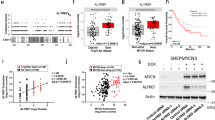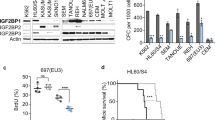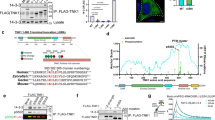Abstract
Arsenite is the most likely carcinogenic form of arsenic in the environment. Previously, expression cloning for cDNAs whose overexpression confers arsenite-resistance in Chinese hamster V79 cells identified two genes: fau and a novel gene, asr2. The fau gene encodes a ubiquitin-like protein (here called FUBI) fused to the ribosomal S30 protein. Since the expression of the fox sequence (antisense to fau) increased the tumorigenicity of a mouse sarcoma virus, it was proposed that fau might be a tumor suppressor gene. We intended to test its ability to block arsenite-induced transformation of human osteogenic sarcoma (HOS) cells to anchorage-independence. Instead, we found that overexpressing fau itself was able to transform HOS cells. When the two domains were expressed separately, only FUBI was transforming and only the S30 domain conferred arsenite resistance. An incidental finding was the transforming activity of the selectable marker, hyg. FUBI belongs to the ubiquitin-like protein group that is capable of forming conjugates to other proteins, although none have so far been identified. Alternatively, FUBI may act as a substitute or inhibitor of ubiquitin, to which it is most closely related, or to close ubiquitin-like relatives UCRP, FAT10, and/or Nedd8.
This is a preview of subscription content, access via your institution
Access options
Subscribe to this journal
Receive 50 print issues and online access
$259.00 per year
only $5.18 per issue
Buy this article
- Purchase on Springer Link
- Instant access to full article PDF
Prices may be subject to local taxes which are calculated during checkout




Similar content being viewed by others
References
Baker RT, Williamson NA and Wettenhall REH . (1996). J. Biol. Chem., 271, 13549–13555.
Chen R-H, Waters JC, Salmon ED and Murray AW . (1996). Science, 274, 242–246.
D'Cunha J, Knight E, Haas AL, Truitt RL and Borden EC . (1996). Proc. Natl. Acad. Sci. USA, 93, 211–215.
Finkel MP, Reilly Jr CA and Biskis BO . (1976). Recent Results Cancer Res, 54, 92–103.
Finley D, Bartel B and Varshavsky A . (1989). Nature, 338, 394–401.
Hermeking H, Lengauer C, Polyak K, He TC, Zhang L, Thiagalingam S, Kinzler KW and Vogelstein B . (1997). Mol. Cell, 1, 3–11.
Hiemstra PS, van den Barselaar MT, Roest M, Nibbering PH and van Furth R . (1999). J. Leukocyte Biol, 66, 423–428.
Hochstrasser M . (1996). Cell, 84, 813–815.
Hochstrasser M . (2000). Science, 289, 563–564.
Hori T, Osaka F, Chiba T, Miyamoto C, Okabayashi K, Shimbara N, Kato S and Tanaka K . (1999). Oncogene, 18, 6829–6834.
Huang S-C and Lee T-C . (1998). Carcinogenesis, 19, 889–896.
Huang C, Li J, Din M, Wang L, Shi X, Castranova V, Vallyathan V, Ju G and Costa M . (2001). Mol. Cell. Biochem., 222, 29–34.
Hummer BT, Li X-L and Hassel BA . (2001). J. Virol., 75, 7774–7777.
Jentsch S and Pyrowolakis G . (2000). Cell Biol, 10, 335–342.
Johnson DG . (2000). Mol. Carcinogenesis, 27, 151–157.
Klemperer NS and Pickart CM . (1989). J. Biol. Chem., 264, 19245–19252.
Kurz T, Pintard L, Willis JH, Hamill DR, Gonczy P, Peter M and Bowerman B . (2002). Science, 295, 1294–1298.
Li Y and Benezra R . (1996). Science, 274, 246–248.
Lin X and Costa M . (1994). Environ. Health Perspect., 102, 289–292.
Liu Y-C, Pan J, Zhang C, Fan W, Collinge M, Bender JR and Weissman SM . (1999). Proc. Natl. Acad. Sci. USA, 96, 4313–4318.
Loeb KR and Haas AL . (1992). J. Biol. Chem., 267, 7806–7813.
McLaughlin PMJ, Helfrich W, Kok K, Mulder M, Hu SW, Brinker MGL, Ruiters MHJ, de Leij LFMH and Buys CHCM . (2000). Int. J. Cancer, 85, 871–876.
Michiels L, Van der Rauwelaert E, Van Hasselt F, Kas K and Merregaert J . (1993). Oncogene, 8, 2537–2546.
Miller AC, Blakely WF, Livengood D, Whittaker T, Xu J, Ejnik JW, Hamilton MM, Parlette E, St John T, Gerstenberg HM and Hsu H . (1998). Environ. Health Perspect., 106, 465–471.
Nakamura M and Tanigawa Y . (1999). J. Biol. Chem., 274, 18026–18032.
Nakamura M, Xavier RM and Tanigawa Y (1996). J. Immunol., 156, 532–538.
Nakamura M, Xavier RM, Tsunematsu T and Tanigawa Y . (1995). Proc. Natl. Acad. Sci. USA, 92, 3463–3467.
Podust VN, Brownell JE, Gladysheva TB, Luo RS, Wang C, Coggins MB, Pierce JW, Lightcap ES and Chau V . (2000). Proc. Natl. Acad. Sci. USA, 97, 4579–4584.
Polyak K, Xia Y, Zweier JL, Kinzler KW and Vogelstein B . (1997). Nature, 18, 300–305.
Potter JL, Narasimhan J, Mende-Mueller L and Haas AL . (1999). J. Biol. Chem., 274, 25061–25068.
Raasi S, Schmidtke G and Groettrup M . (2001). J. Biol. Chem., 276, 35334–35343.
Ramirez P, Eastmond DA, Laclette JP and Ostrosky-Wegman P . (1997). Mutat. Res., 386, 291–298.
Rani AS and Kumar S . (1992). Carcinogenesis, 13, 2021–2027.
Read MA, Brownell JE, Gladysheva TB, Hottelet M, Parent LA, Coggins MB, Pierce JW, Produst VN, Luo RS, Chau V and Palombella VJ . (2000). Mol. Cell. Biol., 20, 2326–2333.
Redman KL and Burris GW . (1996). Biochem. J., 315, 21.
Rhim JS, Park DK, Arnstein P, Huebner RJ, Weisburger EK and Nelson-Rees WA . (1975). Nature, 256, 751–753.
Rossman TG, Visalli MA, Uddin AN and Hu Y . (2001). Arsenic Exposure and Health Effects. Chappel WR, Abernathy CO and Calderon R. (eds), Elsevier Science B.V.: Amsterdam, Chapter 27, pp. 285–295.
Rossman TG and Wang Z . (1999). Carcinogenesis, 20, 311–316.
Sambrook J, Fritsch EF and Maniatis T . (1989). Molecular Cloning. Cold Spring Harbor Laboratory Press: Cold Spring Harbor, NY.
Shin S-I, Freedman VH, Risser R and Pollack R . (1975). Proc. Natl. Acad. Sci. USA, 72, 4435–4439.
Tateishi K, Omata M, Tanaka K and Chiba T . (2001). J. Cell Biol., 155, 571–579.
Tornaletti S and Hanawalt PC . (1999). Biochimie, 81, 139–146.
Vogt B and Rossman TG . (2001). Mutat. Res., 478, 59–168.
Wang Z and Rossman TG . ( 1994). Bio. Tech., 16, 460–463.
Wright G, Albert A and Mobashery S . (1998). Aminoglycoside Antibiotics. New York: Kluwer Academic/Plenum Publishers, pp. 27–69.
Wong JM, Mafune K, Yow H, Rivers EN, Ravikumar TS, Steel Jr GD and Chen LB . (1993). Cancer Res., 15, 1916–1920.
Yang J-J, Kang J-S and Krauss RS . (1998). Mol. Cell. Biol., 18, 2586–2595.
Yeh ETH, Gong L and Kamitani T . (2000). Gene, 248, 1–14.
Acknowledgements
We thank Eleanor Cordisco for her expert help in document preparation. This work was supported by United States Public Health Service Grants R01 ES09252 and P42 ES10344, and is part of NYU's Nelson Institute of Environmental Medicine Center programs supported by Grants ES00260 from NIEHS and CA16087 from NCI.
Author information
Authors and Affiliations
Corresponding author
Rights and permissions
About this article
Cite this article
Rossman, T., Visalli, M. & Komissarova, E. fau and its ubiquitin-like domain (FUBI) transforms human osteogenic sarcoma (HOS) cells to anchorage-independence. Oncogene 22, 1817–1821 (2003). https://doi.org/10.1038/sj.onc.1206283
Received:
Revised:
Accepted:
Published:
Issue Date:
DOI: https://doi.org/10.1038/sj.onc.1206283
Keywords
This article is cited by
-
Exploring the key genes and pathways of side population cells in human osteosarcoma using gene expression array analysis
Journal of Orthopaedic Surgery and Research (2018)
-
Regulation of apoptosis by fau revealed by functional expression cloning and antisense expression
Oncogene (2004)



